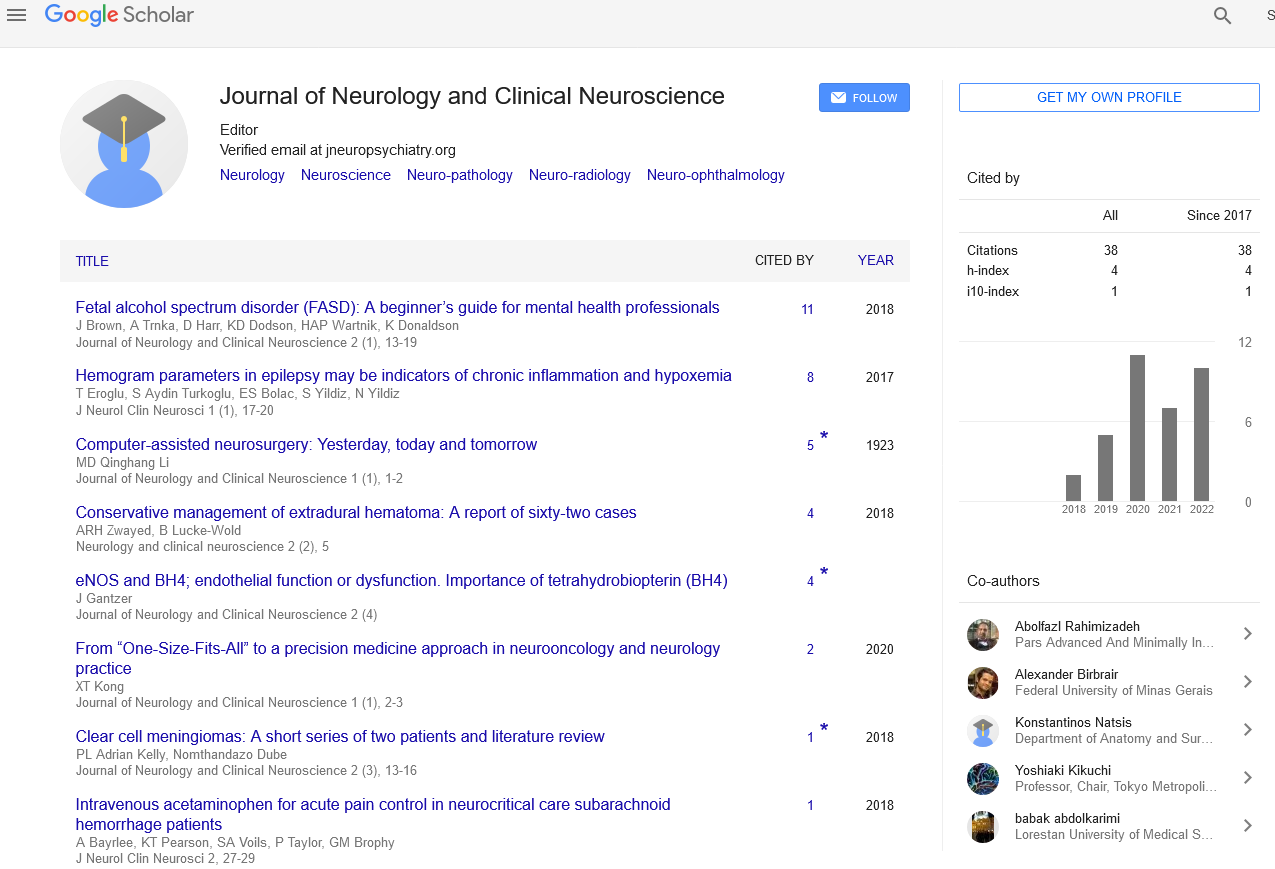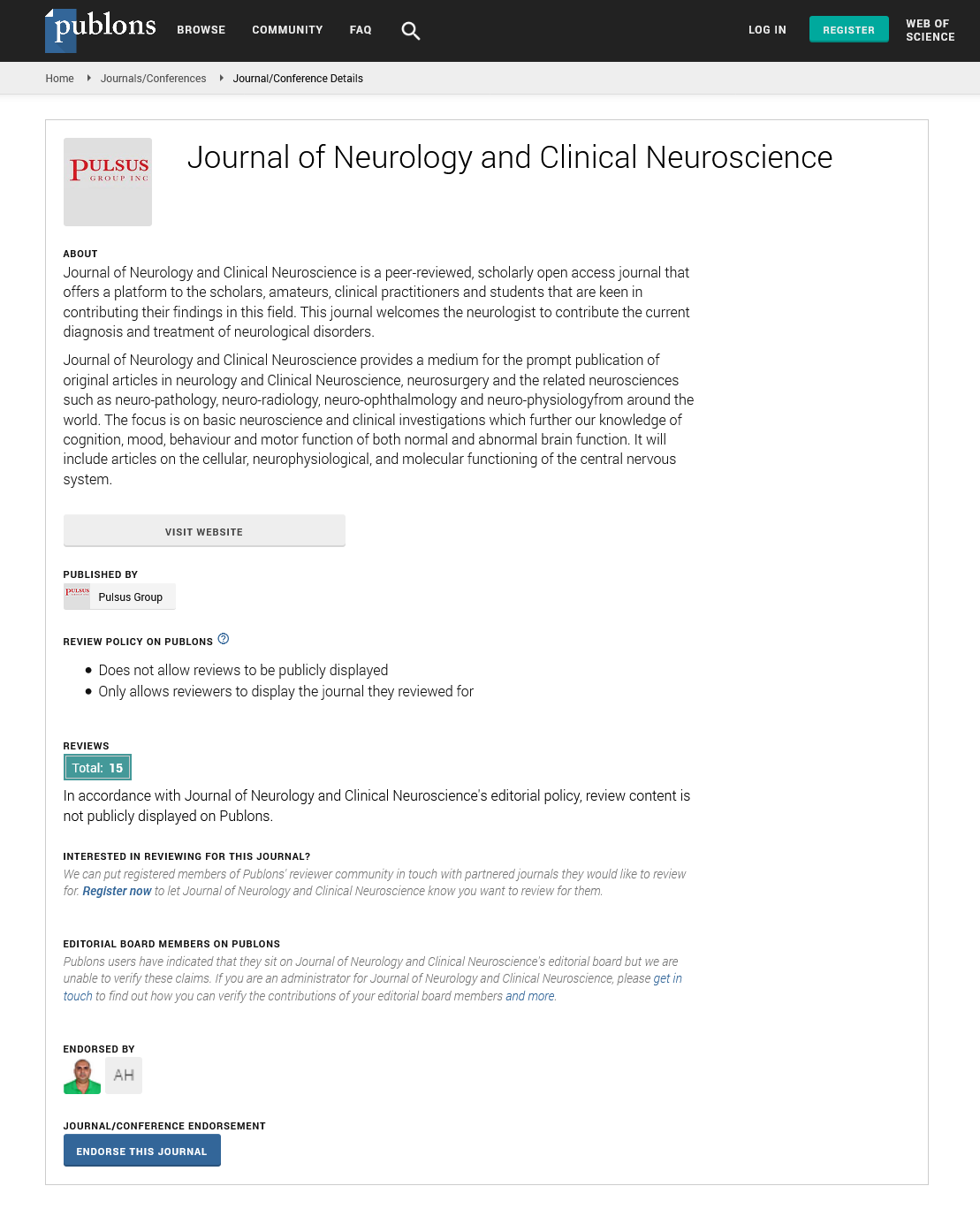From “One-Size-Fits-All” to a precision medicine approach in neurooncology and neurology practice
Received: 12-Sep-2017 Accepted Date: Sep 14, 2017; Published: 20-Sep-2017
Citation: Xiao-Tang Kong. From “One-Size-Fits-All†to a precision medicine approach in neuro-oncology and neurology practice. J Neurol Clin Neurosci. 2017;1(1):4-5
This open-access article is distributed under the terms of the Creative Commons Attribution Non-Commercial License (CC BY-NC) (http://creativecommons.org/licenses/by-nc/4.0/), which permits reuse, distribution and reproduction of the article, provided that the original work is properly cited and the reuse is restricted to noncommercial purposes. For commercial reuse, contact reprints@pulsus.com
Editorial
Precision medicine has gained more attention from the public since former U.S president Barack Obama launched a national “Precision Medicine Initiative” project in his 2015 State of the Union address. The concept of precision medicine is to customize the prevention and treatment regimen for each person based on precision information of genomics, environment, and lifestyle for that individual [1].
While precision medicine is a promising approach in every aspect of medical practice, one successful application of precision medicine to daily practice at the current time is cancer therapy, including brain tumor treatment. Previously, brain tumor treatment after diagnosis was a “one-size-fits-all” approach: surgery, radiation, and/or chemotherapy with fine tuning of doses. Currently, the management of brain tumors has begun to shift to the precision medicine approach based on the genomic information of each cancer. The 2016 World Health Organization (WHO) Classification of Tumors has integrated genomic alterations into the histopathological diagnosis of brain tumors [2]. The new WHO classification has provided a platform for practicing precision medicine in neuro-oncology. For example, instead of the traditional classification of WHO grade II diffuse astrocytoma, the new classification is WHO grade II diffuse astrocytoma, plus IDH mutant or IDH wildtype. Studies have shown that IDH mutant type glioma has a better prognoses than IDH wildtype tumor [3]. Therefore, even with the same histolopathological diagnosis, the low-grade astrocytoma with IDH wildtype is treated more aggressively than the tumor with mutant type [4]. Another important biomarker, 1p19q, co-deletion defines oligodendroglioma in the current era regardless of the presence or absence of traditional histological “fried egg appearance”. With this molecular signature, patients with oligodendrogliomas are treated with Procarbazine, CCNU and Vincristine (PCV) plus radiotherapy, as studies have shown that the median overall survival almost doubles with PCV plus radiotherapy compared to radiotherapy alone [5]. O-6-methylguanine-DNA-methyltransferase gene (MGMT) promoter methylation status is a valuable prognostic biomarker that is used in glioblastoma evaluation and management. Patients with MGMT methylated glioblastoma have significantly increased survival when receiving Temozolomide chemotherapy along with radiation therpy [6]. Thus, single agent Temozolomide is used to treat the elderly patients with MGMT methylated glioblastomas when the combined chemoradiation therapy is not feasible due to the poor functional status of the patient [7].
Immunotherapy and targeted therapy are on the path of finding evidence of efficacy for the treatment of primary brain tumors while they have already been successfully applied in the treatment of brain metastases harboring specific mutations or protein variants [8]. Nivolumab and Ipilimumab combination therapy has increased the survival of patients who have advanced melanomas with brain metastases [9]. Two targeted therapy agents have achieved promising results in the treatment of leptomeningeal carcinomatosis spreading from Non-Small Cell Lung Cancer (NSCLC): Osimertinib for positive EGFR (Epidermal growth factor receptor) mutated NSCLC and Alectinib for ALK (Anaplastic lymphoma kinase gene) rearranged NSCLC [10-12].
Along with neuro-oncology, other neurology subspeciality areas have progressed in gene identification, diagnostic biomarkers, and molecular imaging. This progress has laid a foundation for the application of precision medicine in the diagnosis and management of various neurological diseases, such as Alzheimer’s disease, Parkinson’s disease, amyotrophic lateral sclerosis, epilepsy, multiple sclerosis, and mental disorders [13-16].
In the next decade, we expect to witness more exciting genomic discoveries that will revolutionize neurology practice through precision medicine.
REFERENCES
- Collins FS, Varmus H. A New Initiative on Precision Medicine. N Engl J Med. 2015;372(9):793-5.
- Louis DN, Perry A, Reifenberger G, etal. The 2016 World Health Organization Classification of Tumors of the Central Nervous System: a summary. Acta Neuropathol. 2016;131(6): 803-20.
- Ceccarelli M, Barthel FP, Malta TM, et al. Molecular profiling reveals biologically discrete subsets and pathways of progression in diffuse glioma. Cell. 2016;164(3):550-63.
- Fisher BJ, Hu C, Macdonald DR, et al. Phase 2 study of temozolomide-based chemoradiation therapy for high-risk low-grade gliomas: preliminary results of Radiation Therapy Oncology Group 0424. Int J Radiat Oncol Biol Phys. 2015;91(3):497-504.
- Buckner JC, Shaw EG, Pugh SL, et al. Radiation plus Procarbazine, CCNU, and Vincristine in Low-Grade Glioma. New Eng J Med. 2016;374(14):1344-55.
- Heg, ME, Diserens A, Gorlia T, et al. MGMT gene silencing and benefit from temozolomide in glioblastoma. New Eng J Med. 2005;352(10):997-1003.
- De Moraes FY, Laperriere N. Glioblastoma in the elderly: initial management. Chin Clin Oncol. 2017;6:39.
- Reardon DA, Wen PY, Wucherpfennig KW, et al. Immunomodulation for glioblastoma. Curr Opin Neurol. 2017;30(3):361-9.
- Postow MA, Chesney J, Pavlick AC, et al. Nivolumab and ipilimumab versus ipilimumab in untreated melanoma. New Eng J Med. 2015;372(21):2006-17.
- Sakai H, Hayashi H, Iwasa T, et al. Successful osimertinib treatment for leptomeningeal carcinomatosis from lung adenocarcinoma with the T790M mutation of EGFR. ESMO Open. 2017;2(Suppl 1):e000104.
- Ramalingam S, Yang JC, Lee CK, et al. Osimertinib As First-Line Treatment of EGFR Mutation-Positive Advanced Non-Small-Cell Lung Cancer. J Clin Oncol. 2017; JCO2017747576.
- Ou SI, Ahn JS, De Petris L, et al. Alectinib in Crizotinib-Refractory ALK-Rearranged Non-Small-Cell Lung Cancer: A Phase II Global Study. J Clin Oncol. 2016;34(7):661-8.
- Alessandrini M, Chaudhry M, Dodgen TM et al. Pharmacogenomics and Global Precision Medicine in the Context of Adverse Drug Reactions: Top 10 Opportunities and Challenges for the Next Decade. Omics. 2016;20(10): 593-603.
- Payami H. The emerging science of precision medicine and pharmacogenomics for Parkinson's disease. Movement disorders. 2017;32(8):1139-46.
- EpiPm Consortium . A roadmap for precision medicine in the epilepsies. Lancet Neurol. 2015;14(12):19-28.
- Tan L, Jiang T, Yu J. Toward precision medicine in neurological diseases. Ann Transl Med. 2016;4(6):104.





